
Not too far from Sydney, Australia lays the Blue Mountains that actually do look blue due to the mist caused by the eucalyptus trees. The whole trail is 26 miles in length starting from Katoomba to the Jenolan Caves. Along the way expect to see beautiful valleys, canyons and wildlife. Especially during dawn and dusk, you may be able to see wallabies, kangaroos, possums, gliders, rosellas, lorikeets and lyrebirds; among the amazing sights of the fauna. Also on the list of things to see are the Cox River -- which you cross by a suspended footbridge and of course the limestone formations of the Jenolan Caves. The best times to go are between March and May and September through November. The journey takes about 3 days (plus an additional couple days to look around the caves) and there are lots of campsite locations along the way.
You can even rent horses, rockclimbing, rent bicycles and there's apparently a few festivals and events at different times of the year... one that sounded interesting was the Georg Mertens’ cello concerts in the Jenolan caves.
The whole Blue Mountains Area become a World Heritage site in 2000. The area totals roughly 10,000 square kilometres, including the Blue Mountains, Kanangra-Boyd, Wollemi, Gardens of Stone, Yengo, Nattai and Thirlmere Lakes National Parks, plus the Jenolan Caves Karst Conservation Reserve.
The reason why this site was chosen to be included on the World Heritage list is quoted below:
“ "Criteria (ii) and (iv): Australia’s eucalypt vegetation is worthy of recognition as of outstanding universal value, because of its adaptability and evolution in post-Gondwana isolation. The site contains a wide and balanced representation of eucalypt habitats from wet and dry sclerophyll, mallee heathlands, as well as localised swamps, wetlands, and grassland. 90 eucalypti tax (13% of the global total) and representation of all four groups of eucalypts occur. There is also a high level of endemism with 114 endemic taxa found in the area as well as 120 nationally rare and threatened plant tax. The site hosts several evolutionary relic species (Wollemia, Microstrobos, Acrophyllum) which have persisted in highly restricted micro sites."
No comments:
Post a Comment